Mechanically Robust and Flame-Retardant Polylactide Composites Based on In Situ Formation of Crosslinked Network Structure by DCP and TAIC
Abstract
:1. Introduction
2. Experimental
2.1. Materials
2.2. Preparation of PLA Composites
2.3. Characteristic
3. Results and Discussion
3.1. Verification of Cross-Linked Network Structures
3.2. The Micromorphology of the Fracture Surface
3.3. The Mechanical Properties of PLA and Its Composites
3.4. The Flame Retardant Performance of PLA and Its Composites
3.5. The Structural and Morphology Analysis of Residuary Char of PLA Composites
3.6. The Thermal Performance of PLA and PLA Composites
3.7. The Work Mode of DCP and TAIC in Flame-Retardant PLA
4. Conclusions
- (1)
- Firstly, the crosslinked structure was proved to be formed. Compared with FRPLA, the increase (307%) of torque and the decrease (77.8%) of melt flow rate verified that the addition of 0.9%DCP and 0.3%TAIC could form the effective crosslinked structure. The results of gel content test showed that there was a synergistic cross-linking effect between DCP and TAIC, and the gel content of 0.9DCP/0.3TAIC/FRPLA reached 30.8%, which was the highest among all the PLA composites. Compared with FRPLA, the molecular weight of 0.9DCP/FRPLA decreased by 7.5%, and the molecular weight of 0.3TAIC/FRPLA increased by 39.6%, which verified the catalyzed chain breaking effect of DCP and the chain extender effect of TAIC.
- (2)
- Secondly, the formation of crosslinked network structure could improve the mechanical properties. The tensile strength, elongation at break and the impact strength of 0.9DCP/0.3TAIC/FRPLA increased by 34.8%, 82.6% and 42.9%, respectively, which were the highest among the PLA and FRPLA composites.
- (3)
- Thirdly, the formation of crosslinked network structure could improve the flame retardant performance. Results showed that 0.9DCP/0.3TAIC/FRPLA had the highest LOI value (39.2%) and passed the UL94 V-0 grade without dripping. Compared with FRPLA, the HRR of 0.9DCP/0.3TAIC/FRPLA was reduced by 9.3%, and the final carbon residue increases from 22.6% to 44.8%. This is because the cross-linked structure can effectively form an effective protective carbon layer in the cone calorimeter test.
- (4)
- Finally, the TGA test results showed that the introduction of cross-linked structure can effectively improve the formation of final carbon residue. The DSC test results showed that a obvious crystallization peak can be observed on the cooling curve of 0.9DCP/0.3TAIC/FRPLA at the cooling rate of 10 °C/min, and the crystallinity was as high as 22.6%. It indicated that the addition of 0.9% DCP and 0.3% TAIC could increase the crystallization rate and promote the crystallization of PLA.
Author Contributions
Funding
Institutional Review Board Statement
Informed Consent Statement
Data Availability Statement
Conflicts of Interest
Abbreviations
| Full Name | Abbreviation |
| Poly(lactic acid) | PLA |
| Flame-retardant poly(lactic acid) | FRPLA |
| Thermoplastic polyurethane elastomer | TPU |
| Crosslinked polyurethane | CPU |
| Biobased unsaturated polyester | BPU |
| Poly(butylene succinate) | PBS |
| Polyethylene glycol | PEG |
| Ammonium polyphosphate | APP |
| Microcrystalline cellulose | MCC |
| Methacrylic acid | MA |
| Polyborosiloxane | BSI |
| Carbon black | CB |
| Triglycidyl isocyanurate | TGIC |
| Dicumyl peroxide | DCP |
| Triallyl isocyanate | TAIC |
| Gel permeation chromatography | GPC |
| Melt mass-flow rate | MFR |
| Energy spectrum analysis | EDX |
| Thermogravimetric analyzer | TGA |
| Number-average molecular weight | Mn |
| Weight-average molecular weight | Mw |
| Flame retardant | FR |
| The limiting oxygen index | LOI |
| The time to ignition | TTI |
| Heat release rate | HRR |
| Total heat release | THR |
| Total smoke production | TSP |
| The temperature at 5% mass loss | Tonset |
| The maximum decomposition temperature | Tmax |
| The glass transition temperature | Tg |
| Melting point | Tm |
| Cold crystallization temperature | Tc |
| The heat of fusion | |
| The enthalpy of cold crystallization | |
| The corresponding crystallinity | Xc |
References
- Chen, Y.J.; Wang, W.; Qiu, Y.; Fei, X. Terminal group effects of phosphazene-triazine bi-group flame retardant additives in flame retardant polylactic acid composites. Polym. Degrad. Stabil. 2017, 140, 166–175. [Google Scholar] [CrossRef]
- Xi, W.; Qian, L.J.; Qiu, Y.; Lijun, Q. Flame-retardant behavior of bi-group molecule derived from phosphaphenanthrene and triazine groups on polylactic acid. Polym. Adv. Technol. 2016, 27, 781–788. [Google Scholar] [CrossRef]
- Zhang, Y.; Xiong, Z.Q.; Ge, H.D.; Leikun, N.; Tao, Z.; Siqi, H.; Pingan, S.; Zhengping, F. Ammonia Polyphosphate for Enhancing Flame Retardancy of Polylactic Acid. ACS Sustain. Chem. Eng. 2020, 8, 6402–6412. [Google Scholar] [CrossRef]
- Costes, L.; Laoutid, F.; Dumazert, L.; Brohez, S.; Delvosalle, C.; Dubois, P. Metallic phytates as efficient bio-based phosphorous flame retardant additives for poly(lactic acid). Polym. Degrad. Stabil. 2015, 119, 217–227. [Google Scholar] [CrossRef]
- Chen, Y.J.; Wang, W.; Liu, Z.Q.; Yuanyuan, Y.; Lijun, Q. Synthesis of a novel flame retardant containing phosphazene and triazine groups and its enhanced charring effect in poly(lactic acid) resin. J. Appl. Polym Sci. 2017, 134, 44660. [Google Scholar]
- Zhang, Y.; Jing, J.; Liu, T.; Song, P. A molecularly engineered bioderived polyphosphate for enhanced flame retardant, UV-blocking and mechanical properties of poly(lactic acid). Chem. Eng. J. 2021, 411, 128493. [Google Scholar] [CrossRef]
- Xiong, Z.Q.; Zhang, Y.; Du, X.Y.; Pingan, S.; Zhengping, F. Green and Scalable Fabrication of Core.Shell Biobased Flame Retardants for Reducing Flammability of Polylactic Acid. ACS Sustain. Chem. Eng. 2019, 7, 8954–8963. [Google Scholar] [CrossRef]
- Chen, Y.J.; Xu, L.F.; Wu, X.D.; Bo, X. The influence of nano ZnO coated by phosphazene/triazine bi-group molecular on the flame retardant property and mechanical property of intumescent flame retardant poly (lactic acid) composites. Thermochim. Acta 2019, 679, 178336. [Google Scholar] [CrossRef]
- Zhu, Z.M.; Wang, L.X.; Xue, B.; Liangping, D. Synthesis of a novel phosphorus-nitrogen flame retardant and its application in epoxy resin. Polym. Degrad. Stabil. 2019, 169, 108981. [Google Scholar] [CrossRef]
- Chen, Y.J.; Li, L.S.; Qi, X.Q. The pyrolysis behaviors of phosphorus-containing organosilicon compound modified APP with different polyether segments and their flame retardant mechanism in polyurethane foam. Compos. Part B Eng. 2019, 173, 106784. [Google Scholar] [CrossRef]
- Wei, Z.; Cai, C.; Huang, Y.; Fu, Y. Eco-friendly strategy to a dual-2D graphene-derived complex for poly (lactic acid) with exceptional smoke suppression and low CO2 production. J. Clean Prod. 2020, 280, 124433. [Google Scholar] [CrossRef]
- Mngomezulu, M.E.; Luyt, A.S.; John, M.J. Morphology, thermal and dynamic mechanical properties of poly(lactic acid)/expandable graphite (PLA/EG) flame retardant composites. J. Thermoplast. Compos. 2017, 33, 89–107. [Google Scholar] [CrossRef]
- Yu, T.; Jiang, N.; Li, Y. Functionalized multi-walled carbon nanotube for improving the flame retardancy of ramie/poly(lactic acid) composite. Compos. Sci. Technol. 2014, 104, 26–33. [Google Scholar] [CrossRef]
- Cheng, K.C.; Chang, S.C.; Lin, Y.H.; Wang, C.C. Mechanical and flame retardant properties of polylactide composites with hyperbranched polymers. Compos. Sci. Technol. 2015, 118, 186–192. [Google Scholar] [CrossRef]
- Chen, Y.J.; Mao, X.J.; Qian, L.J. Flammability and anti-dripping behaviors of polylactide composite containing hyperbranched triazine compound. Integr. Ferroelectr. 2016, 172, 10–24. [Google Scholar] [CrossRef]
- Nishida, H.; Fan, Y.J.; Mori, T.; Shirai, Y.; Endo, T. Feedstock recycling of flame-resisting poly(lactic acid)/aluminum hydroxide composite to L, L-lactide. Ind. Eng. Chem. Res. 2005, 44, 1433–1437. [Google Scholar] [CrossRef]
- Wang, D.; Wang, Y.; Wang, W.; Li, T.; Dong, W. Modified alkaline lignin for ductile polylactide composites. Compos. Commun. 2020, 22, 100501. [Google Scholar] [CrossRef]
- Zhou, Y.; Luo, L.; Liu, W.; Guangsheng, Z.; Yi, C. Preparation and characteristic of PC/PLA/TPU blends by reactive extrusion. Adv. Mater. Sci. Eng. 2015, 2015, 393582. [Google Scholar] [CrossRef] [Green Version]
- Sun, C.B.; Mao, H.D.; Chen, F.; Fu, Q. Preparation of polylactide composite with excellent flame retardance and improved mechanical properties. Chin. J. Polym. Sci. 2018, 36, 1385–1393. [Google Scholar] [CrossRef]
- Li, D.F.; Zhao, X.; Jia, Y.W.; Wang, X.L.; Wang, Y.Z. Tough and flame-retardant poly(lactic acid) composites prepared via reactive blending with biobased ammonium phytate and in situ formed crosslinked polyurethane. Compos. Commun. 2018, 8, 52–57. [Google Scholar] [CrossRef]
- Li, D.F.; Zhao, X.; Jia, Y.W.; He, L.; Xiuli, W.; Yuzhong, W. Simultaneously enhance both the flame retardancy and toughness of polylactic acid by the cooperation of intumescent flame retardant and bio-based unsaturated polyester. Polym. Degrad. Stabil. 2019, 168, 108961. [Google Scholar] [CrossRef]
- Suparanon, T.; Surisaeng, J.; Phusunti, N. Synergistic efficiency of tricresyl phosphate and montmorillonite on the mechanical characteristics and flame retardant properties of polylactide and poly(butylene succinate) blends. Chin. J. Polym. Sci. 2018, 36, 620–631. [Google Scholar] [CrossRef]
- Song, Y.P.; Wang, D.Y.; Wang, X.L.; Ling, L.; Yuzhong, W. A method for simultaneously improving the flame retardancy and toughness of PLA. Polym. Adv. Technol. 2011, 22, 2295–2301. [Google Scholar] [CrossRef]
- Yang, Y.; Haurie, L.; Wen, J.; Zhang, S.; Ollivier, A.; Wang, D.Y. Effect of oxidized wood flour as functional filler on the mechanical, thermal and flame-retardant properties of polylactide biocomposites. Ind. Crops Prod. 2019, 130, 301–309. [Google Scholar] [CrossRef]
- Zhang, Q.Y.; Zhang, S.; Gu, X.Y.; Li, H.; Sun, J. Research on Toughening Flame Retarding Polylactic Acid with Ammonium Polyphosphate and Polyethylene Glycol. Mod. Plast. Process. Appl. 2018, 171, 28–31. [Google Scholar]
- Pornwannachai, W.; Ebdon, J.R.; Kandola, B.K. Fire-resistant natural fibre-reinforced composites from flame retarded textiles. Polym. Degrad. Stabil. 2018, 154, 115–123. [Google Scholar] [CrossRef]
- Li, W.Z.; Zhang, L.; Chai, W.S.; Lijuan, L.; Shuhao, Q.; Jie, Y. Enhancement of Flame Retardancy and Mechanical Properties of Polylactic Acid with a Biodegradable Fire-Retardant Filler System Based on Bamboo Charcoal. Polymers 2021, 13, 2167. [Google Scholar] [CrossRef]
- Shukor, F.; Hassan, A.; Islam, M.S.; Mokhtar, M.; Hasan, M. Effect of ammonium polyphosphate on flame retardancy, thermal stability and mechanical properties of alkali treated kenaf fiber filled PLA biocomposites. Mater. Des. 2014, 54, 425–429. [Google Scholar] [CrossRef]
- Bocz, K.; Szolnoki, B.; Farkas, A.; Verret, E.; Marosi, G. Optimal distribution of phosphorus compounds in multi-layered natural fabric reinforced biocomposites. Express Polym. Lett. 2020, 14, 606–618. [Google Scholar] [CrossRef]
- Battegazzore, D.; Frache, A.; Carosio, F. Layer-by-Layer nanostructured interphase produces mechanically strong and flame retardant bio-composites. Compos. Part B Eng. 2020, 200, 108310. [Google Scholar]
- Wang, Y.Y.; Shih, Y.F. Flame-retardant recycled bamboo chopstick fiber-reinforced poly(lactic acid) green composites via multifunctional additive system. J. Taiwan Inst. Chem. E 2016, 65, 452–458. [Google Scholar] [CrossRef]
- Lv, L.; Bi, J.; Ye, F.; Qian, Y.F.; Zhao, Y.P.; Chen, R.; Su, X.G. Extraction of discarded corn husk fibers and its flame retarded composites. Tekst. Konfeksiyon 2017, 27, 408–413. [Google Scholar]
- Zhu, T.; Guo, J.; Fei, B.; Zhengyu, F.; Xiaoyu, G.; Hongfei, L.; Jun, S.; Sheng, Z. Preparation of methacrylic acid modified microcrystalline cellulose and their applications in polylactic acid: Flame retardancy, mechanical properties, thermal stability and crystallization behavior. Cellulose 2020, 27, 2309–2323. [Google Scholar] [CrossRef]
- Liu, L.; Xu, Y.; Di, Y.; Xu, M.; Li, B. Simultaneously enhancing the fire retardancy and crystallization rate of biodegradable polylactic acid with piperazine-1,4-diylbis (diphenylphosphine oxide). Compos. Part B Eng. 2020, 202, 108407. [Google Scholar] [CrossRef]
- Liao, F.; Zhou, L.; Ju, Y.; Yuanyuan, Y.; Xinlong, W. Synthesis of a novel phosphorus-nitrogen-silicon polymeric flame retardant and its application in poly(lactic acid). Ind. Eng. Chem. Res. 2014, 53, 10015–10023. [Google Scholar] [CrossRef]
- Sun, J.; Li, L.; Li, J. Effects of furan-phosphamide derivative on flame retardancy and crystallization behaviors of poly(lactic acid). Chem. Eng. J. 2019, 369, 150–160. [Google Scholar] [CrossRef]
- Zhang, Q.; Wang, W.; Gu, X.; Hongfei, L.; Xiaodong, L.; Jun, S.; Sheng, Z. Is there any way to simultaneously enhance both the flame retardancy and toughness of polylactic acid. Polym. Compos. 2019, 40, 932–941. [Google Scholar] [CrossRef]
- Jing, J.; Zhang, Y.; Tang, X.; Zhou, Y.; Li, X.; Kandola, B.K.; Fang, Z. Layer by layer deposition of polyethylenimine and bio-based polyphosphate on ammonium polyphosphate: A novel hybrid for simultaneously improving the flame retardancy and toughness of polylactic acid. Polymer 2017, 108, 361–371. [Google Scholar] [CrossRef]
- Jian, J.; Yan, Z.; Fang, Z.P.; Wang, D.W. Core-shell flame retardant/graphene oxide hybrid: A self-assembly strategy towards reducing fire hazard and improving toughness of polylactic acid. Compos. Sci. Technol. 2018, 165, 161–167. [Google Scholar]
- Ran, G.W.; Liu, X.D.; Guo, J. Improving the flame retardancy and water resistance of polylactic acid by introducing polyborosiloxane microencapsulated ammonium polyphosphate. Compos. Part B Eng. 2019, 173, 106772. [Google Scholar] [CrossRef]
- Guo, Y.; Chang, C.C.; Halada, G.; Cuiffo, M.A.; Yuan, X.; Zuo, X.; Pack, S.; Zhang, L.; Shan, H.; Weil, E. Engineering flame retardant biodegradable polymer nanocomposites and their application in 3D printing. Polym. Degrad. Stabil. 2017, 137, 205–215. [Google Scholar] [CrossRef]
- Ju, Y.Q.; Wang, T.W.; Huang, Y.; Yuanyuan, Y. The flame-retardance polylactide nanocomposites with nano attapulgite coated by resorcinol bis(diphenyl phosphate). J. Vinyl Addit. Technol. 2016, 22, 506–513. [Google Scholar] [CrossRef]
- Hu, W.; Zhang, Y.; Qi, Y. Improved Mechanical Properties and Flame Retardancy of Wood/PLA All-Degradable Biocomposites with Novel Lignin-Based Flame Retardant and TGIC. Macromol. Mater. Eng. 2020, 305, 1900840. [Google Scholar] [CrossRef]
- Luo, J.; Meng, X.; Gong, W.G.; Zewen, J.; Xin, Z. Improving the stability and ductility of polylactic acid via phosphite functional polysilsesquioxane. RSC Adv. 2019, 9, 25151–25157. [Google Scholar] [CrossRef]
- Wang, X.X.; He, W.; Long, L.; Shaowen, H.; Guomin, X. A phosphorus and nitrogen-containing DOPO derivative as flame retardant for polylactic acid (PLA). J. Therm. Anal. Calorim. 2020, 145, 331–343. [Google Scholar] [CrossRef]
- Lenfeld, P.; Pavel, B.; Borvka, M.; Lubo, B.; Habr, J. Effect of Radiation Crosslinking and Surface Modification of Cellulose Fibers on Properties and Characterization of Biopolymer Composites. Polymers 2020, 12, 3006. [Google Scholar] [CrossRef] [PubMed]
- Krittameth, K.; Nanthicha, T.; Thidarat, K.; Rachtanapun, P.; Leksawasdi, N.; Phimolsiripol, Y.; Rohindra, D.; Ruksiriwanich, W.; Rose Sommano, S.; Jantanasakulwong, K. Reaction Mechanism and Mechanical Property Improvement of Poly(Lactic Acid) Reactive Blending with Epoxy Resin. Polymers 2021, 13, 2429. [Google Scholar]
- Juliana, V.C.A.; Esther, R.D.; Berenika, H.; Bernhard, M. The Effects of Chain-Extending Cross-Linkers on the Mechanical and Thermal Properties of Poly(butylene adipate terephthalate)/Poly(lactic acid) Blown Films. Polymers 2021, 13, 3092. [Google Scholar]
- Wen, X.; Liu, Z.Q.; Li, Z.; Jing, Z.B.; Tao, T.A. Constructing multifunctional nanofiller with reactive interface in PLA/CB-g-DOPO composites for simultaneously improving flame retardancy, electrical conductivity and mechanical properties. Compos. Sci. Technol. 2020, 188, 107988. [Google Scholar] [CrossRef]
- Xu, H.; Sun, J.B.; Li, X.; Lijun, Q.; Juan, L. Effect of phosphorus-nitrogen compound on flame retardancy and mechanical properties of polylactic acid. J. Appl. Polym. Sci. 2021, 138, 49829. [Google Scholar]
- Chen, Y.J.; Wu, X.D.; Li, M.Q.; Lijun, Q. Construction of crosslinking network structures by adding ZnO and ADR in intumescent flame-retardant PLA composites. Polym. Advan. Technol. 2021, 1–14. [Google Scholar] [CrossRef]
- Chen, Y.J.; He, J.X.; Xu, L.F.; Bo, X.; Lijun, Q. Mechanical properties and flame retardancy of PLA composites containing zinc oxide and chain extender. J Appl. Polym. Sci. 2021, e50987. [Google Scholar] [CrossRef]
- Walong, A.; Thongnuanchan, B.; Uthaipan, N.; Tadamoto, S.; Natinee, L. Enhancing cellular structure, mechanical properties, thermal stability and flame retardation of EVA/NR blend nanocomposite foams by silicon dioxide-based flame retardant. Prog. Rubber Plast. Recycl. Technol. 2021. [Google Scholar] [CrossRef]
- Zhang, L.; Chai, W.S.; Li, W.Z.; Kate, S.; Ningning, Y.; Wenbiao, Z.; Chunping, D. Intumescent-Grafted Bamboo Charcoal: A Natural Nontoxic FireRetardant Filler for Polylactic Acid (PLA) Composites. ACS Omega 2021, 6, 26990–27006. [Google Scholar] [CrossRef] [PubMed]
- Chen, P.; Yu, K.S.; Wang, Y.Q.; Hongfu, L. The effect of composite nucleating agent on the crystallization behavior of branched poly (Lactic Acid). J. Polym. Environ. 2018, 26, 3718–3730. [Google Scholar] [CrossRef]
- Liu, L.; Xu, Y.; Pan, Y.; Xu, M.; Li, B. Facile synthesis of an efficient phosphonamide flame retardant for simultaneous enhancement of fire safety and crystallization rate of poly (lactic acid). Chem. Eng. J. 2020, 421, 127761. [Google Scholar] [CrossRef]
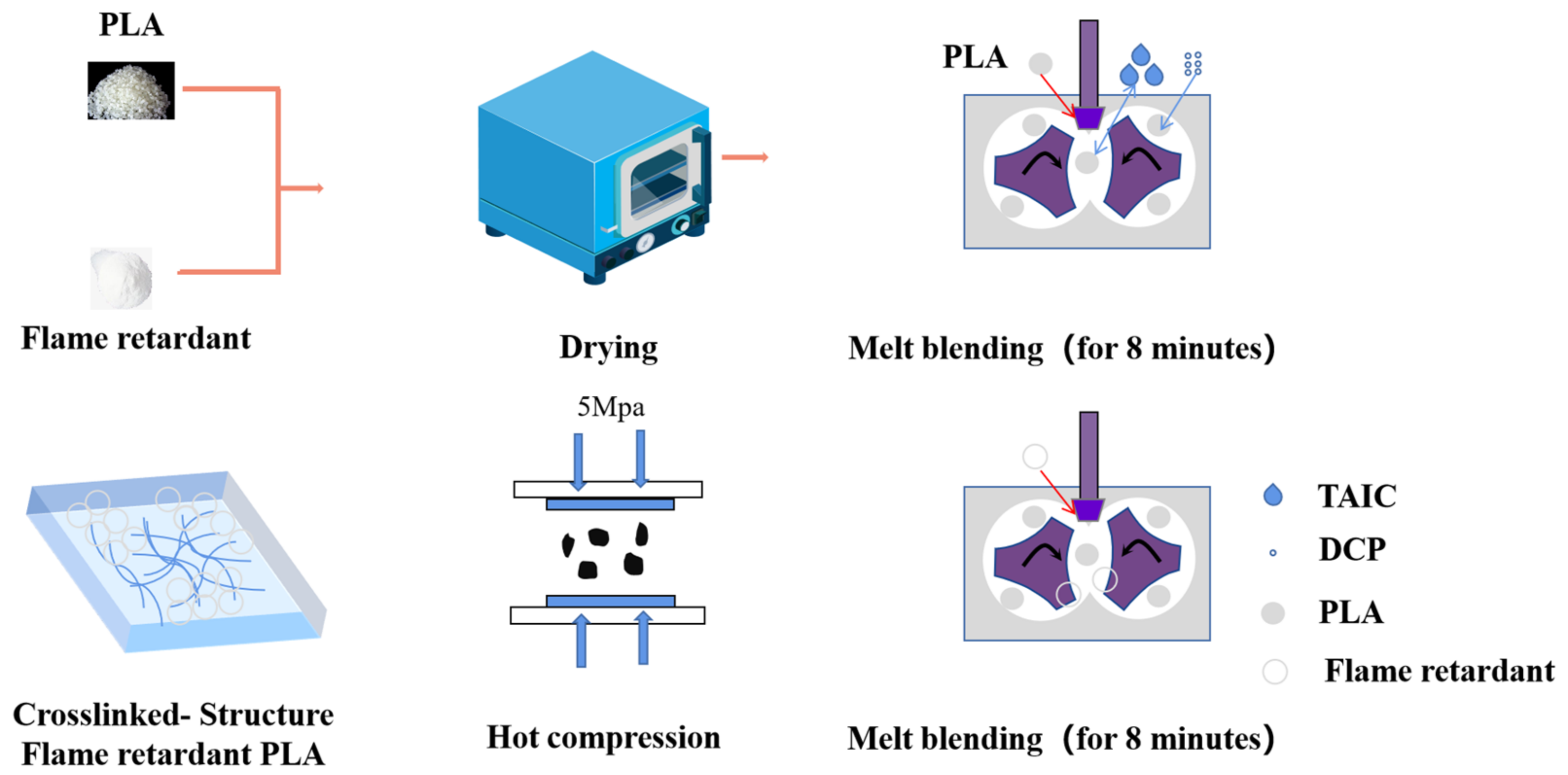
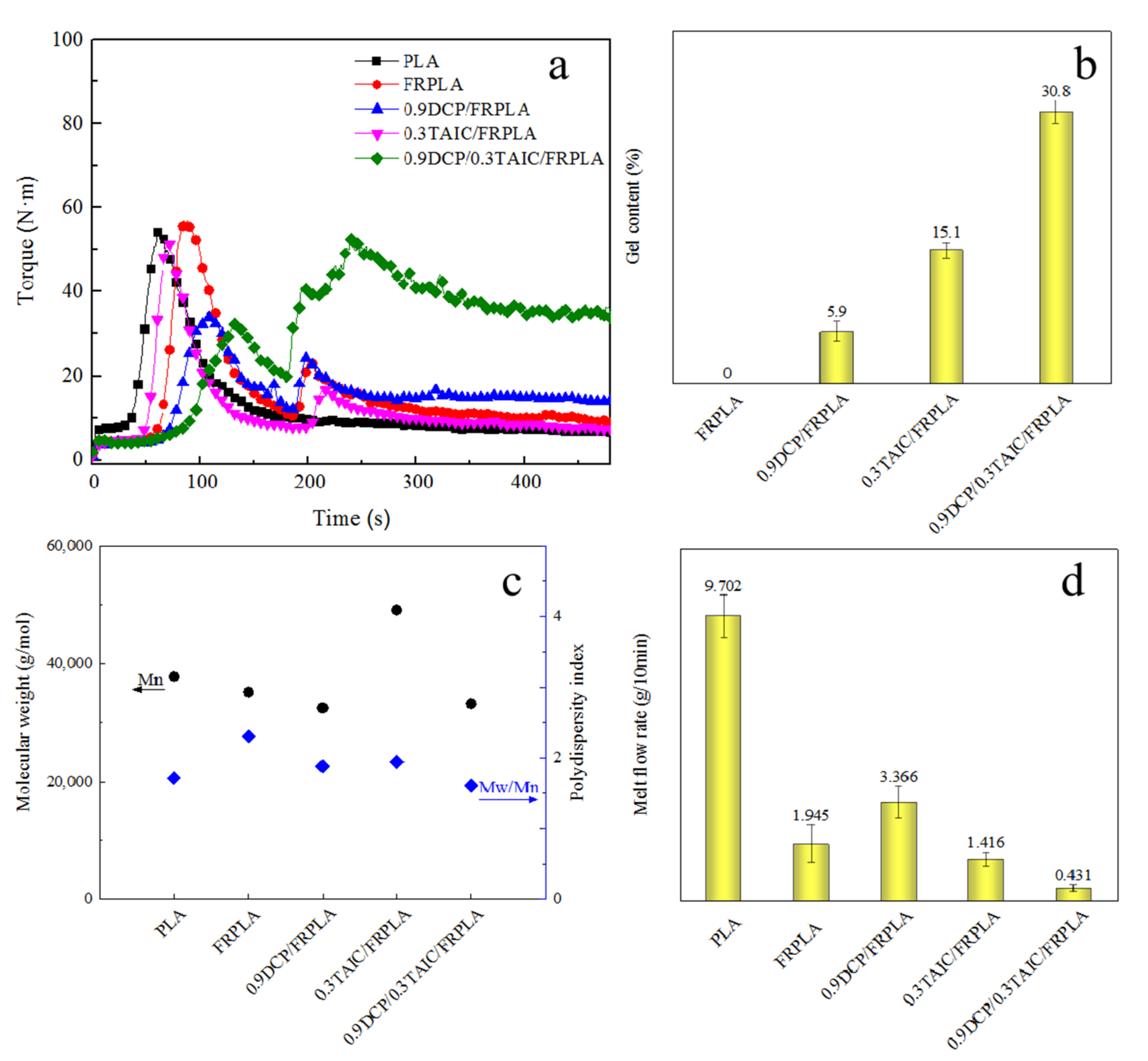
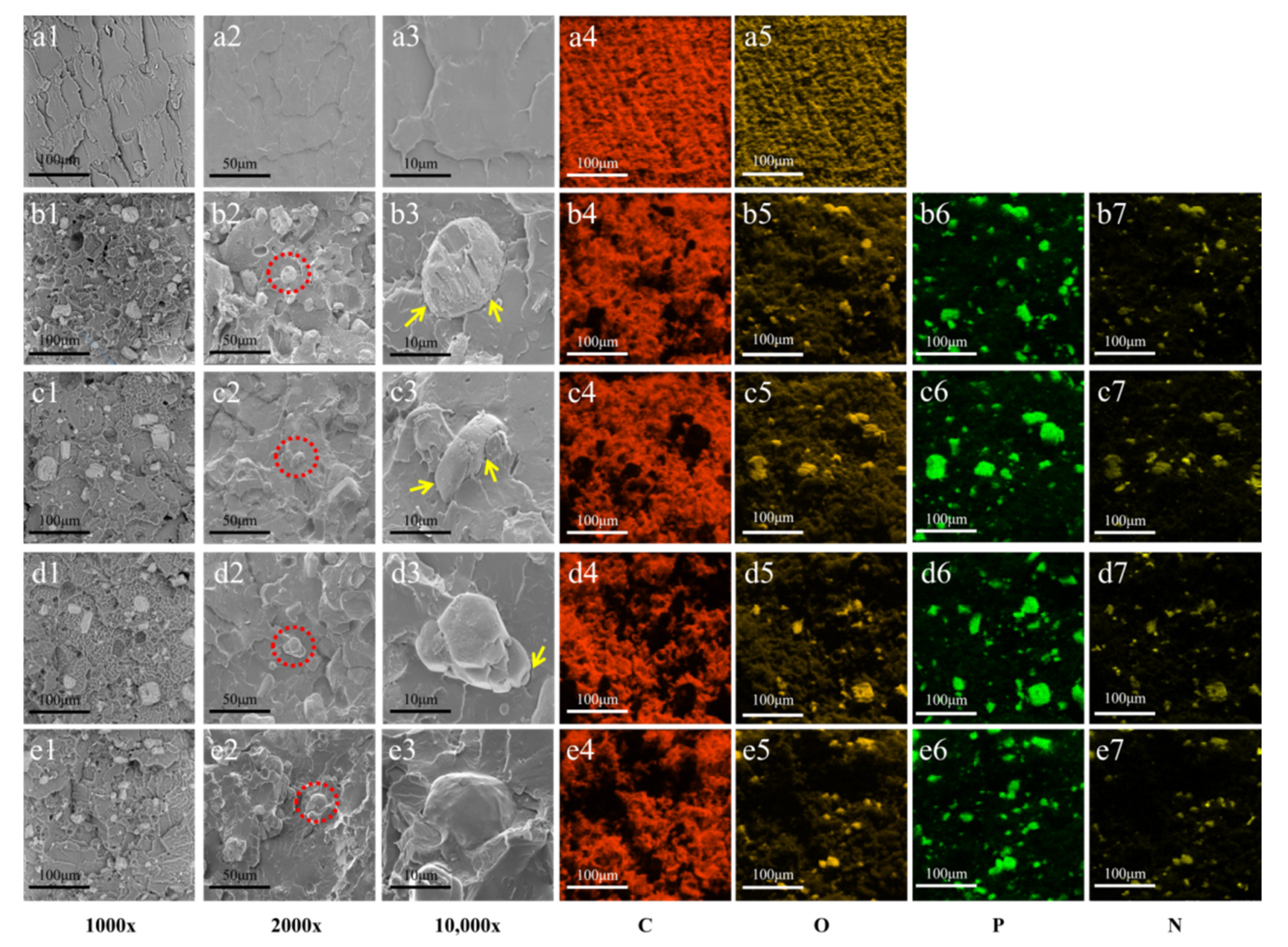


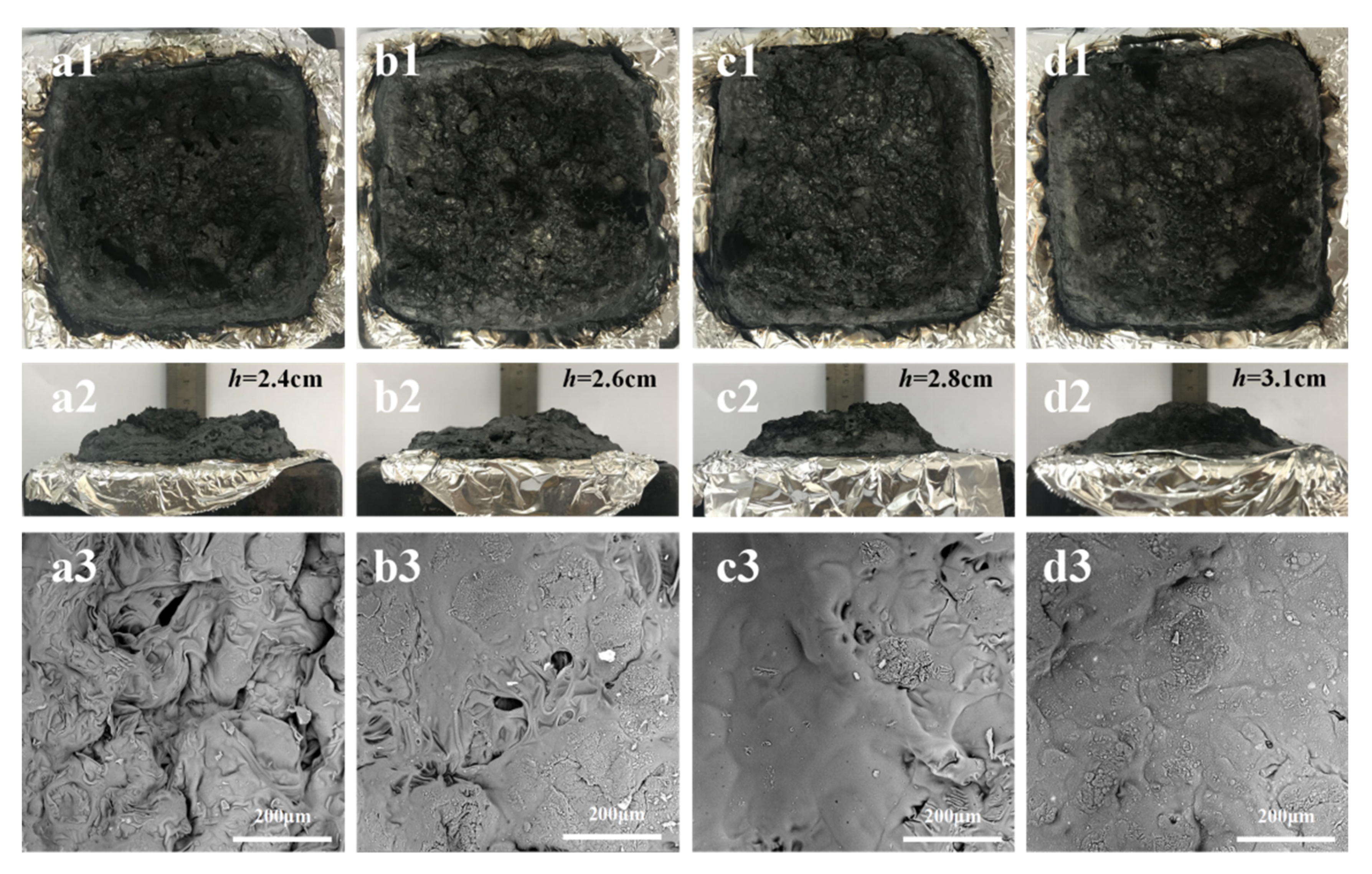
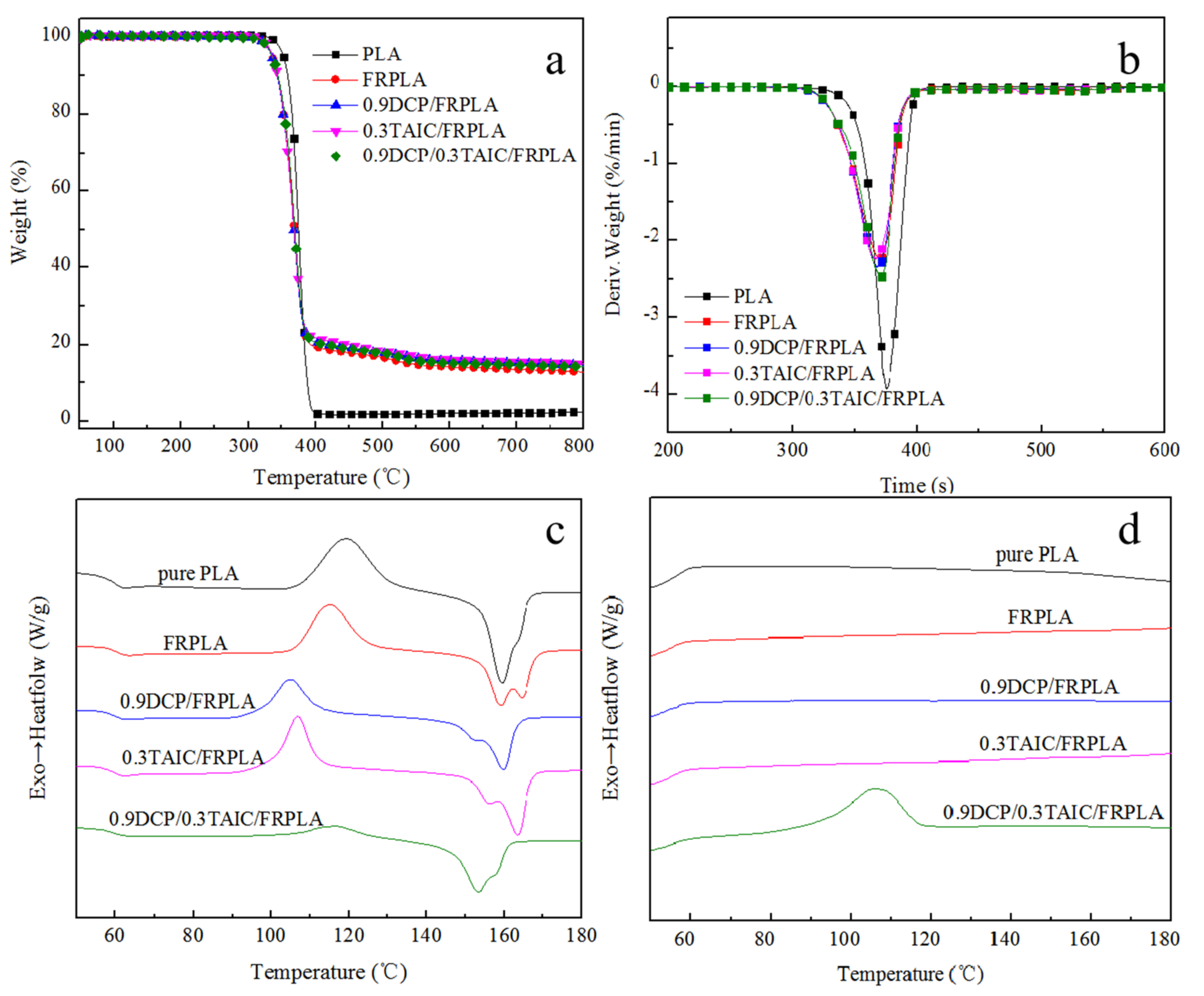
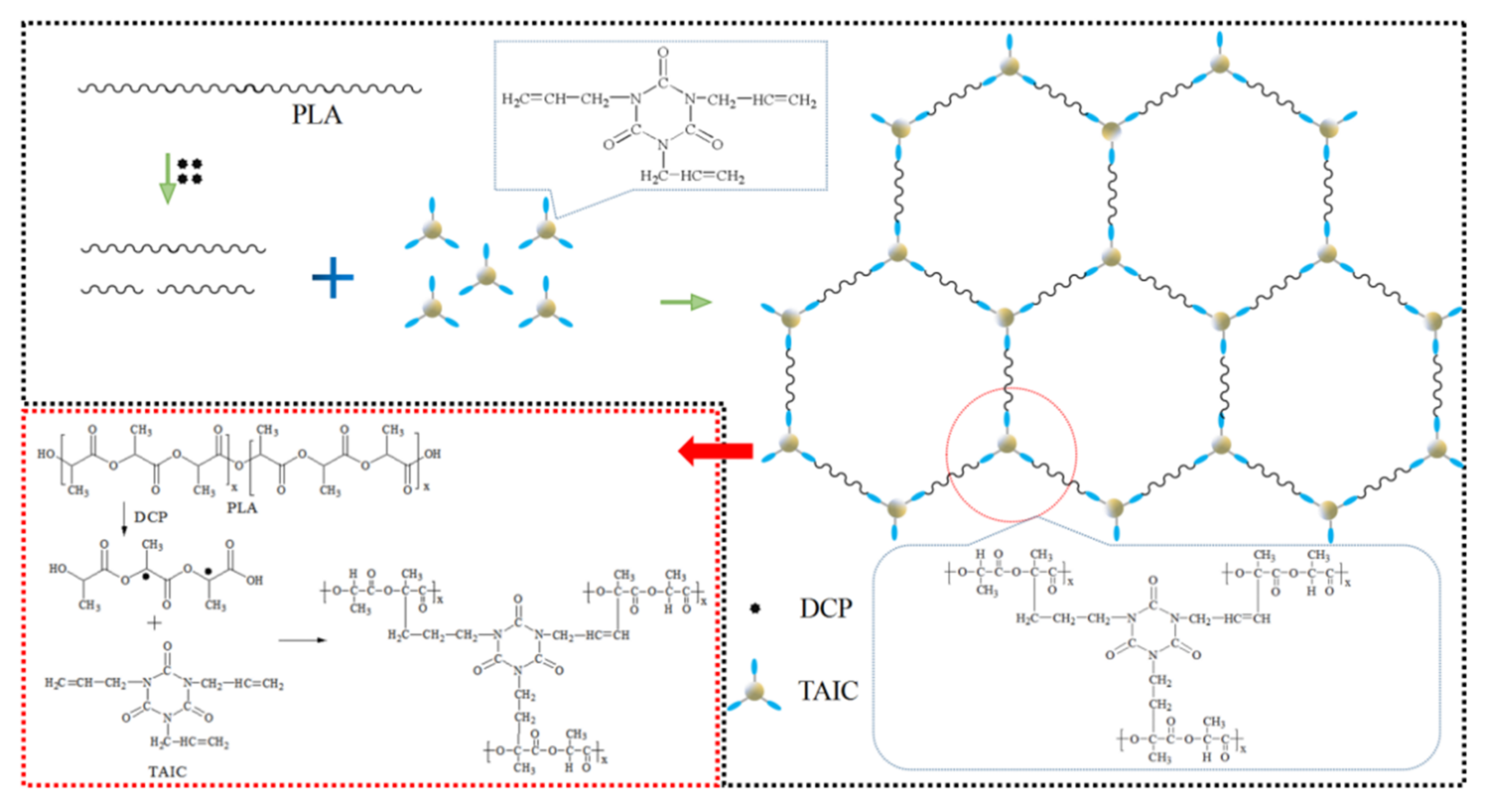
| Number | Sample | PLA (g) | Triazine | APP | DCP | TAIC | TAIC | |||
|---|---|---|---|---|---|---|---|---|---|---|
| (g) | (wt%) | (g) | (g) | (g) | (wt%) | (g) | (wt%) | |||
| 1 | PLA | 200 | 0 | 0 | 0 | 0 | 0 | 0 | 0 | 0 |
| 2 | FRPLA | 160 | 8 | 4 | 32 | 0 | 0 | 0 | 0 | 0 |
| 3 | 0.9DCP/FRPLA | 160 | 8 | 4 | 32 | 0 | 0 | 0.9 | 0 | 0 |
| 4 | 0.3TAIC/FRPLA | 160 | 8 | 4 | 32 | 0.48 | 0.48 | 0 | 0.48 | 0.3 |
| 5 | 0.9DCP/0.3TAIC/FRPLA | 160 | 8 | 4 | 32 | 0.48 | 0.48 | 0.9 | 0.48 | 0.3 |
| Sample | TTI (s) | pk-HRR (kW/m2) | av-HRR (kW/m2) | THR (MJ/m2) | av-MLR (g/s) | Final Mass (wt%) | TSR (m2/m2) |
|---|---|---|---|---|---|---|---|
| PLA | 39 | 494 | 249 | 87 | 0.111 | 0.2 | 30 |
| FRPLA | 28 | 119 | 43 | 42 | 0.034 | 22.6 | 563 |
| 0.9DCP/FRPLA | 26 | 111 | 64 | 37 | 0.040 | 44.9 | 241 |
| 0.3TAIC/FRPLA | 27 | 97 | 57 | 38 | 0.033 | 45.2 | 244 |
| 0.9DCP/0.3TAIC/FRPLA | 30 | 108 | 57 | 38 | 0.036 | 44.8 | 140 |
| Samples | N2 | ||
|---|---|---|---|
| Toneset/°C | Tmax/°C | Residual at 600 °C (wt%) | |
| PLA | 353 | 380 | 2.1 |
| FRPLA | 337 | 374 | 14.2 |
| 0.9DCP/FRPLA | 336 | 373 | 15.8 |
| 0.3TAIC/FRPLA | 337 | 374 | 16.1 |
| 0.9DCP/0.3TAIC/FRPLA | 337 | 374 | 15.7 |
| Samples | Tg (°C) | Tm (°C) | (J/g) | (J/g) | Xc (%) | Tc (°C) |
|---|---|---|---|---|---|---|
| PLA | 60.3 | 159.4 | 33.1 | 31.1 | 2.1 | 119.2 |
| FRPLA | 60.6 | 159.1 | 26.1 | 23.4 | 3.6 | 114.9 |
| 0.9DCP/FRPLA | 60.6 | 159.8 | 21.5 | 16.5 | 6.6 | 104.6 |
| 0.3TAIC/FRPLA | 60.3 | 163.3 | 24.9 | 21.3 | 4.9 | 106.9 |
| 0.9DCP/0.3TAIC/FRPLA | 59.6 | 153.3 | 23.6 | 6.7 | 22.6 | 116.6 |
Publisher’s Note: MDPI stays neutral with regard to jurisdictional claims in published maps and institutional affiliations. |
© 2022 by the authors. Licensee MDPI, Basel, Switzerland. This article is an open access article distributed under the terms and conditions of the Creative Commons Attribution (CC BY) license (https://creativecommons.org/licenses/by/4.0/).
Share and Cite
Chen, Y.; Wu, X.; Li, M.; Qian, L.; Zhou, H. Mechanically Robust and Flame-Retardant Polylactide Composites Based on In Situ Formation of Crosslinked Network Structure by DCP and TAIC. Polymers 2022, 14, 308. https://doi.org/10.3390/polym14020308
Chen Y, Wu X, Li M, Qian L, Zhou H. Mechanically Robust and Flame-Retardant Polylactide Composites Based on In Situ Formation of Crosslinked Network Structure by DCP and TAIC. Polymers. 2022; 14(2):308. https://doi.org/10.3390/polym14020308
Chicago/Turabian StyleChen, Yajun, Xingde Wu, Mengqi Li, Lijun Qian, and Hongfu Zhou. 2022. "Mechanically Robust and Flame-Retardant Polylactide Composites Based on In Situ Formation of Crosslinked Network Structure by DCP and TAIC" Polymers 14, no. 2: 308. https://doi.org/10.3390/polym14020308
APA StyleChen, Y., Wu, X., Li, M., Qian, L., & Zhou, H. (2022). Mechanically Robust and Flame-Retardant Polylactide Composites Based on In Situ Formation of Crosslinked Network Structure by DCP and TAIC. Polymers, 14(2), 308. https://doi.org/10.3390/polym14020308







